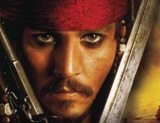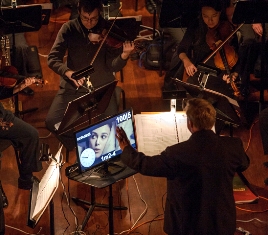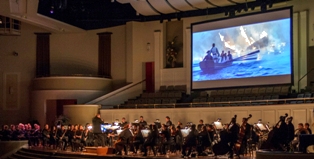Kentucky Symphony Orchestra's "Pirates" Swashbuckling Tribute to Film Music
Mary Ellyn Hutton
Posted: Oct 16, 2012 - 7:07:45 PM in
reviews_2012

Johnny Depp as Jack Sparrow in "Pirate of the Caribbean"
|
(first published in The Cincinnati Enquirer Oct. 16)
The Kentucky Symphony Orchestra’s live accompaniment Saturday to Disney’s “Pirates of the Caribbean: The Curse of the Black Pearl” at Florence Baptist Church at Mt. Zion came as the perfect foil to the Cincinnati Pops’ “Superheroes” concert Friday night.
Both were devoted to film music. The Pops at Music Hall had “Batman” and “The Avengers” and composers Danny Elfman and Alan Silvestri. The KSO had Capts. Jack Sparrow and Barbossa, and composers Klaus Badelt and Hans Zimmer. Both came just in time for Halloween.
KSO music director James R. Cassidy has led live accompaniment to films before, mostly silent, including “Ben-Hur,” “Phantom of the Opera” and “The Freshman.” (The one talkie was “The Wizard of Oz” in 2007.) “In silent films you attempt to hit precise visual cues marked in the score and you don’t have dialogue that you may risk covering,” he said.

KSO music director James R. Cassidy conducting "Pirates of the Caribbean" (photo by Jim Fausz)
|
Not so with “Pirates.” Cassidy had a fierce task to grapple with. Not only is the music complex, but synchronizing it with the film is daunting. The whole exercise, according to Cassidy, was “a mind fry” in which he not only had to conduct and draw the best possible performance from the orchestra, but do it precisely in sync with the film.
In addition to conducting from the score, he had to follow a click track through ear buds and refer to a monitor mounted on the podium next to his
music stand. The monitor fed him information throughout the show, including the title of the portion being performed (“The
Black Pearl,” “Will and Elizabeth,” etc.), a countdown clock, measure numbers
and beats, digital time and downbeat flashes, all superimposed on the film itself.

photo by Jim Fausz
|
The performers were positioned at the head of the church sanctuary beneath the projection screen. Cassidy put together a fine orchestra for the event, 65 players plus a 19-voice male choir drawn from the KSO Chorale. The film dialogue and some sound effects went through the house sound system; the KSO and KSO Chorale and more synthesized musical effects came from the stage. The whole had a very natural, unified acoustic effect. At no time was one distracted by the musicians performing onstage.
It was a costly undertaking for the KSO, said Cassidy, “the most expensive production we have undertaken in 21 seasons. Normally, the KSO builds its big shows using friends, collaborators and resources to cut down on costs. When you bring in a show like this, you pay the sticker price.”
All totaled, it will be upward of $40,000, he said.
It is a rollicking, action-packed score with lots of atmosphere – and, for the performers, a maddening number of tempo and meter changes.
“There
is rarely a steady tempo," Cassidy said. "Such tiny
fluctuations are not marked and really can’t be. You just have to be on top of it.”
The opening “Fog Bound” set the mood with a spooky wash of winds, percussion and special effects. With Johnny Depp (Jack Sparrow) on the scene, the familiar swashbuckling theme began to thread through the score.
For the battle scenes, there was plenty of hell-raising by the pounding, fully-armed KSO, as the swaggering Sparrow and glowering Barbossa (Geoffrey Rush) pursued their conflicting ends, and Elizabeth and Will (
Keira
Knightley and Orlando Bloom)
pursued each other. It was a thoroughly delightful show, and everyone went home happy to the tune of “He’s a Pirate.”
The event was potent witness to the importance of film music. “There is no language that can convey the full spectrum of human emotion like music,” Cassidy said.
“Without a film’s score, there probably is no audience connection with the mood, feelings, atmosphere of the characters or their settings. The score is an integral part of our cinematic experience.”



